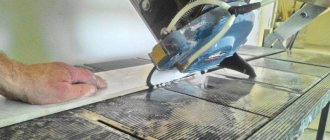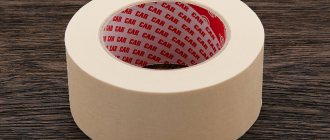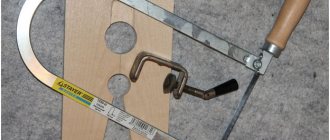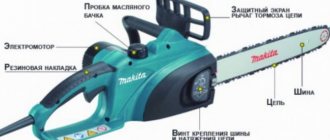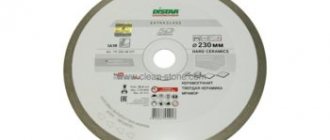For modern tilers, the reliability and quality of equipment have long been at the forefront, displacing ancient traditions. So stone-cutting machines have rightfully taken their place, significantly speeding up and facilitating the work process and increasing its efficiency. Electric tile cutters are good because they can be used to make any cut, insertion, or cut grooves. The quality of the cutting line is at a high level. In addition, these machines can handle a wide range of materials, from ceramics to natural stone.
Device
An electric tile cutter is a machine-type device consisting of a cutting part, a motor, guides and a cooling system. This is a stationary unit, since it is a table with basic working equipment. The cutting part consists of a diamond-coated disk; such a disk provides high-quality cutting of a wide variety of materials, including brick and concrete. With the right choice of disk and feed speed, the machine can handle any surface processing without any problems.
What is the difference from simple ones?
Cutting is a dusty business, which raises the issue of eliminating small particles. For this purpose, there are liquid cooling for stone cutting machines. During operation, water is supplied to the table, with the help of which the parts are cooled, dust settles, and the cutting area is lubricated. This allows you to achieve fast and clean work and an even cut, without chips or glaze defects.
Such a machine has another, no less important property, namely it prevents the disk from overheating, which in turn:
- Increases the performance of the diamond blade.
- Allows you to work with different types of materials.
- Significantly improves the quality of work and allows you to do more in the same time.
This results in both the higher cost of the machine and the specificity of its maintenance. Such a tile cutter will require careful monitoring of the water level in the container.
Manual tile cutters also prevent dust formation, but specialize only in cutting tiles and ceramics.
Best water cooled tile cutters
Tile cutters equipped with water cooling differ from others in their high efficiency and extended service life. Water is supplied from the reservoir simultaneously with the cutting element being turned on. In this way, you can solve two problems at once: prevent overheating of the diamond disc and reduce the amount of dust in the surrounding space during processing of tiles.
There are two types of such tools: manual and professional. It is best to work manually only in a horizontal plane to avoid increased dust formation. If more complex work is required, then it is difficult to do without professional equipment.
Some of the advantages of using water-cooled tile cutters include:
- significant increase in the service life of the diamond blade;
- the ability to cut harder materials such as glass, natural or artificial stone and others;
- the ability to carry out large volumes of work without wasting time on cooling the cutting element;
- increasing the efficiency of work, regardless of its duration.
DeWALT DWC410
This excellent water-cooled electric tile cutter is designed for cutting marble, granite, paving slabs, artificial stone, glass and ceramics. With its help you can make cuts at an angle of 45 degrees. Due to the use of water cooling, the cutting disc does not overheat. This also helps to significantly reduce dust formation.
Other advantages include:
- powerful 1300 W motor;
- long service life;
- comfort in use;
- maximum cutting depth 34 mm;
- the ability to adjust the cutting angle up to 45 degrees;
- cutting depth adjustment.
Flaws:
- high noise level.
ELITECH PE 800/62Р
According to user reviews, this tile cutter is an excellent choice for both professional and household use. To make it easier to move, the device is equipped with a pair of roller wheels. Built-in disk cooling system provides high performance and greater reliability. Using ELITECH PE 800/62P you can cut all types of tiles, including porcelain stoneware. The presence of a protective shutdown increases safety in the event of an unexpected breakdown.
Advantages:
- high performance;
- presence of a cut length limiter;
- high precision guide;
- cable and water system protection;
- Possibility of desktop and floor installation.
Flaws:
- heavy weight (up to 40 kg).
Makita CC301DZ
This diamond saw is equipped with a special water container with a large neck for wet cutting. The ergonomic and lightweight design allows you to work much longer without feeling tired. This is also facilitated by a special sole, with which you can guide the tool along the working surface. The main feature of this device is the ability to operate on battery power, which will come in handy in places where there is no access to an electrical network. Essentially, this is one of the best cordless tile cutters on the market.
Other advantages:
- the presence of a reliable protective casing;
- endurance to stress;
- Nickel plated base;
- ability to work with lithium-ion batteries;
- rubberized handle.
Flaws:
- water supply is not always correct;
- no battery included.
CALIBER PLE-200/1000
This tile cutter is well suited for those who want to purchase high-quality equipment at an affordable price. It is well suited for working with stone and ceramics. Thanks to a powerful 1000 W motor and a cutting disc with a diameter of 200 mm, it can cut almost any facing material. The disk cooling water accumulates in the tray, ensuring cleanliness in the workplace.
Other benefits:
- ease of operation;
- collection of water and dust;
- combination of cost and opportunity;
- relatively light weight.
Flaws:
- not suitable for professional work.
Types and classification
Such machines are usually classified according to the principle of the location of the cutting disk.
There are tile cutters:
- With bottom disk arrangement
Designed for small cutting depths and quite compact. They have an angular protractor for diagonal cutting, convenient for processing larger area tiles.
- Top Disc
A stationary machine, much larger than the previous type. Designed for deep cutting, guarantees high quality work and perfect accuracy.
How to choose a machine?
Before choosing a machine, you need to decide what exactly it will process - i.e. what depth of cut is needed and what will be the area to be processed.
Selection criteria
- The ratio of the depth of cut and the diameter of the cutting disc is necessary in order to know what thickness of material the disc can handle. For example, for ceramic tiles a machine with a depth of 45-60 mm and a disk of 200-300 mm is suitable.
- Ease of operation - check how well all the tile cutter handles work.
- Possibility of quick disk replacement.
- Cut length - shows how long the workpiece can be cut by the machine. Depends on the size of the table.
- Efficiency of assembly of the machine, ease of transportation.
- Availability of a folding frame.
- Possibility to lock the cutting part.
- Availability of protective devices.
- Disk rotation speed – the recommended range is from 3000 to 4500 rpm.
- Depth adjustment.
- Ability to control the entire work area.
- Efficiency of drainage.
- Availability of waste compartments.
- The amount of water circulation during pump operation.
- Power – you should choose a machine with an engine power of at least 1 kW, otherwise it simply will not cope with the required amount of work.
Expert opinion
Torsunov Pavel Maksimovich
Of course, it is not necessary that all points be present - depending on the model or purpose, tile cutters differ strikingly from each other in configuration. But if you can give a “plus” to at least half of the list, it will be much easier to choose.
What tile cutter do you use?
ManualElectric
The best electric tile cutters
Ceramic tiles whose thickness exceeds 15 mm become quite problematic to cut using mechanical tools, because it is necessary to apply much greater force than the pressure of a hand allows. Therefore, electric tile cutters, which look like a circular saw, are used for these purposes. They consist of a work table and a cutting tool itself.
Such devices allow you to make both straight cuts and at an angle of 45 degrees. Since the tiles are cut through and through, there are no defects such as chips and others characteristic of hand-held mechanical tools. Electric tile cutters are divided into two types: with top or bottom drive. The first type is more popular due to its greater functionality.
Using such equipment you can cut not only tiles, but also more serious materials, for example:
- natural and artificial stone;
- concrete;
- glass;
- granite.
Makita 4101RH
This device is one of the best electric tile cutters in terms of reliability. Its characteristics allow it to be in a leading position in the TOP 10. The maximum cutting depth of 35 mm allows it to be used when cutting almost any finishing material.
Recommended for use in professional activities that require good performance and reliability of the tool.
Advantages:
- presence of a circuit breaker;
- permissible diameter of the diamond disc is 110-125 mm;
- presence of water cooling;
- sophisticated cooling system;
- power 860 W;
- rotation speed 13800 rpm.
The disadvantage is the relatively high cost, which is justified by the fact that for this price one of the best electric tile cutters is purchased.
Messer M125
This device is designed for cutting stone products and surfaces. In terms of quality, the tile cutter is in a leading position. Maximum performance and long service life are ensured by a water supply system that cools the working area, allowing you to work for a long time without the risk of damaging the diamond blade. For safety reasons, it is equipped with an electric shock protection system. This device is the best electric tile cutter with mains operation.
Among the advantages can be noted:
- powerful 1200 W motor;
- the presence of an additional casing on the disk;
- possibility of installing a concave disk for shape cutting;
- comfortable handles;
- decent equipment.
The only downside is the cost, which is not affordable for everyone.
DIAM ML-180/700
This tile cutter is one of the best in terms of price and quality. With its help, you can quickly, efficiently and efficiently cut tiles. It can be used for cutting ceramics and porcelain stoneware. Depending on the material, you can install different disc options. This good corded electric tile cutter is relatively compact, highly efficient and low noise.
Other advantages of the device include:
- no restrictions on the length of the cut;
- ability to cut at an angle of 45 degrees;
- disc diameter 180 mm;
- can be chamfered;
- table with high-quality galvanized coating;
- maximum cutting depth 34 mm.
The disadvantage is the non-removable bath.
Specifics of water supply
There are 2 types of systems for water-cooled electric tile cutters:
- Regular - water is simply served on the table and flows into another container. The downside is that you need to constantly add water and change waste disposal containers.
- Circular circulation of water is a more advanced option. The disadvantage of the system is that in the second and subsequent circles the pump will drive dirty water with small particles and dust.
When choosing stationary tile cutters, it is necessary to take into account all the operating features of the water cooling system. It would be ideal if the water spray nozzles were adjustable. In addition, you need to pay attention to the drainage of waste water - the presence and location of protective screens and containers, drainage channels and the size of the table perforation. It is recommended to choose a machine with strong water circulation, as well as a large collector for collecting waste.
Main classification
The supply market today is huge and varied, and therefore the purchase can sometimes drag on for a long time. Various nuances, operating features and even the type of device - all this can affect the final choice.
Let's consider two main types of this kind of tool.
Tabletop
The first type of tools that are considered popular in the domestic market are desktop options. Why are they so common?
It's all in their design. A tabletop tile cutter is a machine that is convenient for cutting tiles. The design itself in detail, of course, can vary quite a lot, but the general points are usually similar. For example, a bed. For a device of this kind, it can not only be part of the tool, but it can also be removed.
The desktop tile cutter has its own operating characteristics
It is also important to note other criteria when choosing a tabletop tile cutter. For example, this type of tool may have different disk feed (upper or lower), different CO (air or water), and different design. As a rule, buying a powerful tabletop tile cutter with water CO is considered the right choice not only for the amateur, but also for the professional. This option is capable of high-quality cutting of tiles of any size. One “but” - you need to constantly add water to a separate tank to avoid overheating.
It is worth considering not only compactness, but also shape. The tool should not only work well, but also not take up too much space.
Choosing the best tabletop tile cutter can be quite difficult.
Portable
There is another, no less popular option - a portable tile cutter, which is easy to transport from place to place in the work environment.
Sometimes this type of device has a frame and, if there is one, it becomes much easier to work. Even if it is not there, the item can be placed on a hard surface, which will become a working surface. In any case, everything is quite simple with portable devices that can be used by both amateur and professional.
There are two interesting subtypes of mobile tile cutters, which we will now discuss below.
| View | Description |
| Pencil cutter | As a rule, when they talk about a mobile tile cutter, this is the option they mention. The arsenal includes a glass cutter and blades for breaking off the cut pieces. The cheapness of the tool does not make it an ideal option. |
| Tile cutter-nippers | With such a tool, interestingly, you can make rather non-standard recesses. Among other professional tools, this tile cutter will look very good. However, it cannot be said that this option is ideal for constantly cutting tiles. |
Different types of portable tile cutters are interesting in their own way.
Separately, it is worth mentioning mini-devices, the weight of which does not exceed four kilograms. Whether they are electrical or mechanical – it doesn’t matter. The main thing is a handle that is comfortable to grip, as well as a sharp cutting surface. These two criteria already influence the fact that the work will go exactly as it should.
An electric tile cutter is usually considered the best option. This choice may be due to several reasons. Its electric motor is usually powerful enough to cut tiles of any strength. Water CO is also considered a necessary component of a tile cutter. Its presence is determined only by the possibility of overheating of the instrument in the event of prolonged operation of the device and the absence of air or water cooling.
A portable option with a large number of functions, the cost can be equal to a professional tool
You might be wondering how to choose a good welding helmet .
Rating of the best models
DIAM SPmax-250/1.5
- Pros: precise cutting without dust, powerful motor, durable frame, easy to use.
- Disadvantage: the pump requires an additional reservoir.
Sergey G.: “I needed a tile cutter for 60x90cm porcelain stoneware with the ability to cut at an angle and rectangular holes. After a long study of the market, I chose this one. I wasn't disappointed. For the money this is the best option.”
MTX 87689
- Pros: high-quality assembly, fast delivery.
- Cons: fragile carriage alloy.
Vasily K.: “I cut the tiles in a straight line 65.5 cm, the cut was smooth, after adjusting the tile cutter!”
Battipav Super Pro 750
- Plus: powerful monorail.
- Cons: difficult to use.
Roman S.: “An excellent, powerful, productive machine at an affordable price.”
Helmut FSC180
- Plus: value for money.
- Cons: none found.
Dmitry R. “Satisfied. Price and quality are on par. Even with a standard disc."
ELITECH PE 800/62Р
- Pros: simple configuration, convenient lifting and tilting of the carriage, stable.
- Cons: inaccurate water supply.
Pshenichny A.: “The fact that water splashes to the left of the machine is the norm. The table is not infinite, and the tiles are large, so it drips. But keep in mind that there will be a puddle under the machine. The set of keys is raw, but it’s not scary.”
ELITECH PE 600
- Pros: quiet operation, protection against electric shock.
- Minus: when water is supplied, liquid flows onto the floor.
Stanislav P.: “It’s just right for the home.”
MONTOLIT Masterpiuma 63P3
- Pros: high-quality cut, powerful engine.
- Cons: none found.
Rashid K.: “Awesome tile cutter, worth the money, for professionals.”
Matrix 87688
- Plus: value for money.
- Cons: Inaccurate ruler and square.
Arslan A.: “It clicks ceramics like seeds, porcelain tiles like nuts. The main thing is not to press with the roller: gently, carefully) then the cut will be without chips and the roller will last longer.”
Engy ETC-3000
- Plus: value for money.
- Minus: the disk is offset relative to the desktop.
Evgeniy Ch.: “I thought that 450 W would not be enough for ceramic floor tiles, but no, it copes with a bang. Of course, not for professional work, for repairs on your own it’s perfect.”
RUBI Speed-62 N
- Plus: clean cuts when working with tiles.
- Cons: high price.
Igor K.: “Excellent cut. 10mm lightweight porcelain stoneware. The manufacturer did not disappoint. Before this there was a cheap but popular one, which had to be regularly modified and tuned. This one saved me from everything - took it out of the box and went ahead, shredding it. If you want to work with it for a long time and with high quality, buy it and you won’t regret it.”
Electric or manual tile cutter?
Manual tile cutter
A manual tile cutter is used for cutting tiles up to 1.5 centimeters thick. Its design is as follows:
There are mechanical, roller tile cutters, as well as tools on bearings.
- Roller - it is the carbide roller that is the cutting element;
- Mechanical - cut the material using a rigid carriage (for tiles of medium thickness);
- On bearings - such tools are suitable for cutting very durable tiles (up to 1.6 cm thick). The tile cutters have a soft stroke because they have bushings on 2 bearings.
Advantages of manual tile cutters:
- Mobility, light weight (up to 9 kg);
- To use a tile cutter, you don’t need to set aside a whole room or a large table, just a small space on the floor is enough;
- Such tools are independent of electricity and economical;
- They can be used in all weather conditions, even high humidity.
Functionality. Tile cutters can bite off small pieces from the edge, make a cut along which the tile is broken manually, or cut ceramic completely. Additional attachments are also good: for example, rollers and nippers for curly cuts, circular cutting elements. For household work, a mechanical tile cutter is sufficient, but for large volumes it is recommended to choose an electric one. High-quality models have various options: prevention of crumbling and chipping, micro-regulation of material thickness, measuring rulers - very useful for novice craftsmen.
Material. It is desirable that there are no plastic parts in the mechanism and body of the tile cutter - such products are less resistant to wear and do not guarantee precise processing. The body of the tool must be made of durable metal; check whether the handle is comfortable - it is better to choose rubberized products. The tile cutter should not be small: the optimal length is 35-40 centimeters, otherwise it will simply be inconvenient for you to use it.
Price issue. Frankly budget models are good for rare jobs. If you don’t have enough money for an electric tile cutter, it is better to choose a high-quality manual one: it should be universal (for both floor and wall tiles). Models with bearings have proven themselves well - they move more smoothly.
The main disadvantage of manual tile cutters is the limitations on the thickness and length of the tiles. It is unlikely that they can be used to process clinker tiles or cut thin fragments of tiles (chips and breaks are possible). You are unlikely to be able to handle a large amount of work with hand tools, but as a tool for a home craftsman’s piggy bank, this is what you need!
Tips for work
Proper use of the tool is the key to its long and high-quality operation. As for the tile cutter, it also means confidence that a lot of money will not be wasted.
Here are some tips that will improve and extend the life of your machine:
- It is imperative to observe safety regulations when working (!), carry out work only with safety glasses, gloves, a helmet and headphones.
- When cutting material, you should never move the cutting disc in the opposite direction - this will lead to chips at the cut.
- Before you start working, you need to set all the necessary values, selecting a disk of the required diameter and determining the desired angle.
- When moving the cutting disc, it is necessary to apply clamping forces proportional to the thickness of the surface being processed.
- Before processing, it is better to secure the material on the table as securely as possible.
- The cutting part must be moved confidently so that there is no vibration and the disk does not jam.
- On machines with a regular water supply, constantly replace the trays as soon as waste has accumulated.
- Monitor the condition of the disk - if it is severely worn, the engine may burn out due to increased loads.
